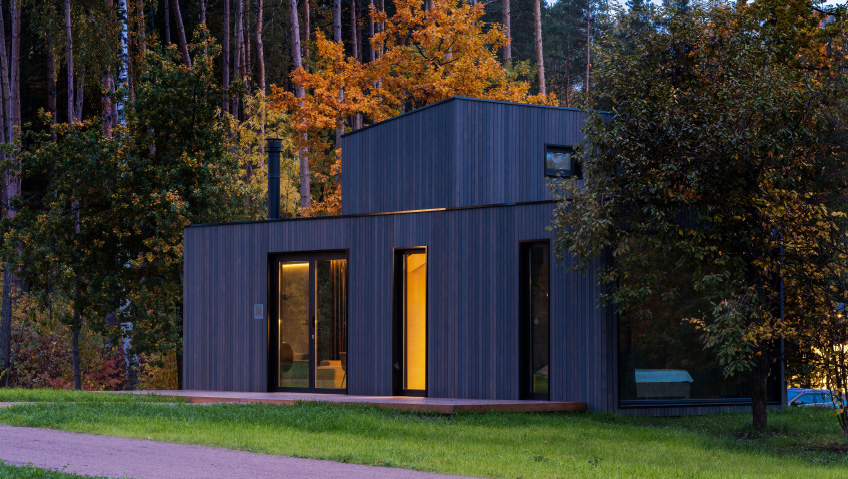It is impossible to turn on the TV or check the news without hearing about the nation’s dire housing crisis. According to the Canada Mortgage and Housing Corporation (CMHC), issues include lack of affordability, short supply, too few tradespeople, high interest rates, and the fact that we Canadians are just not making enough to afford $2,500 or more per month for a one-bedroom apartment in Ontario.
In its report Housing shortages in Canada: Updating how much housing we need by 2030, the CMHC details the urgency, saying that 3.5 million additional housing units are needed by 2030. And while all provinces and territories are feeling the crunch, more housing is needed in the country’s most densely populated provinces like Ontario (with a population fast approaching 16 million), Quebec (around 9,100,000), British Columbia (over 5.6 million), and Alberta (4.1 million).
The blame game
Who is to blame for Canada getting to the housing breaking point? Some point the finger at “greedy” banks and high interest rates. Others fault wealthy foreign buyers, who for years gobbled up everything from condos to mansions in British Columbia and other provinces, which continued until Canada’s Deputy Prime Minister and Minister of Finance Chrystia Freeland announced the extension of the federal government’s existing ban on foreign ownership by another two years back in February. Others are critical of the hundreds of thousands of foreign students coming to Canada, some eyeing it as a pathway to permanent resident status. And some lay the blame squarely at the feet of developers.
Shelving the blame for a moment, what is the solution? Some have proposed modular housing and units made from shipping containers, while others say building up and creating density along existing roads and transit lines is the answer.
Observations from an architect
Over the past 30 years, architect Graham Smith has seen and heard it all regarding the housing crisis. Managing Principal at Toronto-based Altius Architecture Inc., Smith and his team have created over 650 individual projects, all of them boutique, and definitely at the upper end of the market. These include everything from full-blown houses to kitchen renovations.
The company has served as contractor; BCIN (Building Code Identification Number, a unique ID code required in Ontario) qualified designer; architect; construction manager, supervising the building process; and many other roles. Projects include modular housing, prefab housing, steel, engineered lumber—practically every single form of housing there is.
“I sit here and say, we are the last industry that produces this boutique, ‘have it your way’ type of service. We are the haute couture of architecture,” says Smith from the firm’s Queen Street West office. “We have clients who come in, and we say, ‘we will do whatever you want, and it will be new and different.’ And you sit there and say, ‘What industry on the planet still does that? It’s insane!’” He compares this situation to manufacturers making custom cars years ago, something that doesn’t happen anymore.
Financial constraints
Despite the lack of affordable housing, many still hold onto the dream of homeownership in Canada. Prices, however, remain a major roadblock. Even with a slight recent drop, the average selling price of a home in Canada is $717,800. And that is just the average. The price in Ontario is $817,915, and well over a million dollars in the Greater Toronto Area (GTA).
“Clearly, the average Canadian cannot afford to purchase the average Canadian house,” says Smith, adding that monthly mortgage payments of thousands of dollars—together with meeting the rising costs of food, clothing, education, and savings—are not only prohibitive but impossible for many families to meet even with multiple incomes. After all these bills plus day-to-day expenses, few have much left over.
“Once you remove housing costs from the average Ontarian’s bank account, the average family has somewhere between $10,000 and $32,000 left for all other expenses,” Smith says. “You’ve got the CMHC touting all their programs for affordable housing, but they haven’t looked at the basic facts: who can build it? It’s not like developers can magically reduce the cost of housing.”
Having done all types of housing for 15 years, his conclusion is that all are costly to build, including prefab.
Another issue, says Smith, is the question of what, exactly, constitutes affordable housing. According to the CMHC, it is housing that costs less than 30 percent of a household’s before-tax income.
In real-world terms, this is unrealistic. Last year, the average Canadian family had a combined income of $109,000 pre-tax and paid $47,000 in taxes. For housing to be ‘affordable,’ the average Canadian family should be spending no more than $32,700 a year on housing. However, major cities like Vancouver and Toronto often demand much higher rents.
“In our most populated cities, the average Canadian cannot afford to live, plain and simple,” says Smith, “and that’s certainly what we are seeing in the marketplace. The CMHC invested in social equality and governance, when all people care about is having a roof over their heads.”
Instead of well-intended but ineffectual grants, programs, and drop-in-the-bucket, feel-good initiatives that barely scratch the surface of the housing crisis, there’s a simple solution, says Smith: stop taxing Canadians so highly. Marginal tax rates are extremely high, he says, and there is an affordability problem because Canadians simply don’t have enough money left at the end of the month for their housing. “Simultaneously, you have the Canadian government overtaxing Canadian households; they are also overtaxing the people who build houses. And this whole idea that there’s a non-profit and NGO group capable of supplying housing to Canadians is laughable. Instead of someone building 10 houses, they really should be building 10,000.”
As a housing industry veteran, Smith says Canadians need to get past the idea that builders are bad people driven by profit. No one is in business with the goal of losing money, and many ignore the high cost of construction, including material prices, skilled trades, and permit fees. Every time municipalities revise building codes, the cost of housing increases.
According to Smith, cash-starved municipalities Canada-wide need to confront their own issues—including staffing and expenses—and become smaller, more efficient, and more accountable. In his own Toronto experience, inspections and permitting take months, and thousands of dollars are paid for projects to go before the Committee of Adjustment. “Civil servants act like a police force, making lives as difficult as possible,” he says. “They’ve lost touch with the idea of what a civil servant is.”
Even with a growing population and enormous demand for housing, Canada’s housing starts are going down. People are clamouring for housing, but developers aren’t building, which calls for a much closer look at the reasons why.
One reason, says Smith, is the changes constantly being made to the Ontario Building Code. While some are well-intentioned, they end up costing Smith’s clients more money. One example is insulation. R14 on 2” x 4” walls became R24 on 2” x 6” walls, with continuous insulation on the outside. “It’s saving energy, but costs way more for the average household than it saves,” he says.
Plain and simple, there is a need to find ways to reduce the cost of housing. The issue is that this won’t happen with what developers are doing now: building generic tract home subdivisions and soaring towers. Developers can be painfully slow to innovate; in the past 30 years, the biggest change to subdivision homes was the addition of the family room. Many want this additional room, yet few take advantage of it, creating additional space that remains largely unused.
Runaway infrastructure
One of the most expensive aspects of construction today is infrastructure. In new subdivisions, everything must be created from scratch, including parks, waterlines, sewers, sidewalks, and roads. Development fees charged by municipalities have skyrocketed tenfold in some cases, with developers now paying $150,000 to $200,000 per unit on development charges. Add in provincial land transfer taxes, and another four percent land transfer tax in Toronto on top of development charges, building fees, committee of adjustment fees, carrying costs, connection fees to existing waterlines, and more, and these costs are passed on to buyers.
“It’s gotten to where developers have reached the breaking point where they can’t do it anymore because of their costs,” says Smith. “The Carbon Tax doesn’t help either, because it’s a tax on everything. So you have the government saying, ‘We need housing,’ and the private sector, which builds all the housing, saying, ‘We can’t do it.’ So what’s going to happen?”
Missing the chance
In Toronto, changes were made to allow multiplex housing city-wide. According to the city, a multiplex is “a residential building with two, three, or four units—also called a duplex, triplex, or fourplex, as defined by the Zoning By-Law. To qualify as a duplex, triplex, or fourplex, at least one dwelling unit must be entirely or partially above another.” Builders can now create four units in the footprint of one, in any neighbourhood, without having to rezone, effectively creating an opportunity to take 826,000 individual properties and turn them into two or three million properties if done correctly.
“It’s an enormous opportunity to densify Toronto neighbourhoods, and a lot of Toronto neighbourhoods could use densification,” says Smith. “And that makes it cheaper for government to service those people because they are on existing roads, sidewalks, and infrastructure.”
Although this opportunity exists, Smith says that developers, accustomed to building hundreds of homes on one tract of land, are reluctant to build disparate houses—one on this block, two on another block.
“Big developers don’t know how to do it; they know how to marshal large developments. Mom-and-pop small-time developers can’t do it either, because they can’t get financing. And while they know how to build, they don’t know how to navigate zoning, permitting, and how to use housing once they’ve got it. Is the house owned by the landlord? Is he renting it out? Then he expects to make a profit from it. If the cost of housing is prohibitive in the first place, how could they possibly rent out at the average Canadian rent to the average Canadian family? The answer is, they can’t.”
Breaking the impasse
With an estimated population of almost 42 million and growing, Canada is at an impasse. What the country needs, says Smith, is a completely new type of housing, a disruptor. There needs to be a way to reduce taxes and building costs and create an ownership model that works and is accessible. Homeownership must also allow people to live their entire lives in the neighbourhood, with housing options that address their needs from early adulthood until death. This currently doesn’t exist.
“We have this amazing opportunity in front of us, but it is going to take an enormous amount of research, development, product development, and effort to literally redefine what a house is and figure out how to mass-produce it within the cities where we already have achieved density—with existing services, schools, fire departments, police, and all that,” says Smith.
“Is anybody going to be able to do it? Probably not, because it’s an opportunity I don’t think anybody is going to figure out how to seize. So we’re just going to continue on our merry way, business as usual, because we have developers who know how to build, but… they don’t like change.” The talent exists, but there need to be incentives for the talent to change things.






